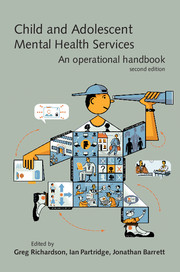Book contents
- Frontmatter
- Contents
- Tables, boxes and figures
- Contributors
- Abbreviations
- Preface
- 1 Introduction
- 2 CAMHS in context
- 3 CAMHS and the law
- 4 Structure, organisation and management of CAMHS
- 5 Evidence-based practice
- 6 Clinical governance
- 7 Education, supervision and workforce development
- 8 Multidisciplinary working
- 9 User and carer participation and advocacy
- 10 A comprehensive CAMHS
- 11 Referral management
- 12 Demand and capacity management
- 13 Strategies for working with Tier 1
- 14 Structuring and managing treatment options
- 15 CAMHS in the emergency department
- 16 Paediatric liaison
- 17 Self-harm
- 18 Learning disability services
- 19 Services for autism-spectrum disorders
- 20 Attentional problems services
- 21 Eating disorder teams
- 22 Bereavement services
- 23 CAMHS for refugees and recent immigrants
- 24 CAMHS and looked-after children
- 25 Drug and alcohol teams
- 26 Parenting risk assessment service
- 27 Court work
- 28 Tier 4 options
- 29 In-patient psychiatric care
- 30 Forensic services
- 31 Neuropsychiatry and neuropsychology services
- 32 Mental health provision for deaf children: study of a low-incidence service provision
- 33 Chief Executives – what do they want and how do they get it?
- Index
4 - Structure, organisation and management of CAMHS
Published online by Cambridge University Press: 02 January 2018
- Frontmatter
- Contents
- Tables, boxes and figures
- Contributors
- Abbreviations
- Preface
- 1 Introduction
- 2 CAMHS in context
- 3 CAMHS and the law
- 4 Structure, organisation and management of CAMHS
- 5 Evidence-based practice
- 6 Clinical governance
- 7 Education, supervision and workforce development
- 8 Multidisciplinary working
- 9 User and carer participation and advocacy
- 10 A comprehensive CAMHS
- 11 Referral management
- 12 Demand and capacity management
- 13 Strategies for working with Tier 1
- 14 Structuring and managing treatment options
- 15 CAMHS in the emergency department
- 16 Paediatric liaison
- 17 Self-harm
- 18 Learning disability services
- 19 Services for autism-spectrum disorders
- 20 Attentional problems services
- 21 Eating disorder teams
- 22 Bereavement services
- 23 CAMHS for refugees and recent immigrants
- 24 CAMHS and looked-after children
- 25 Drug and alcohol teams
- 26 Parenting risk assessment service
- 27 Court work
- 28 Tier 4 options
- 29 In-patient psychiatric care
- 30 Forensic services
- 31 Neuropsychiatry and neuropsychology services
- 32 Mental health provision for deaf children: study of a low-incidence service provision
- 33 Chief Executives – what do they want and how do they get it?
- Index
Summary
‘Here is Edward Bear, coming downstairs now, bump, bump, bump, on the back of his head, behind Christopher Robin. It is, as far as he knows, the only way of coming downstairs, but sometimes he feels that there really is another way, if only he could stop bumping for a moment and think of it. And then he feels that perhaps there isn't.’
A. A. Milne, Winnie the PoohIntroduction
The starting point of the management structure of CAMHS must be the young person and family – not the requirements of the institution. We are still learning about what suits young people and families best, but a service based on the principles described in Together We Stand(NHS Health Advisory Service, 1995) appears to go some way to meeting them. For the service to be geared to meeting the needs of the local community and its partner agencies, it must be clearly structured and efficiently managed (Box 4.1). It must understand the reality of commissioning priorities, staffing and retention levels, and shifts in national, regional or local initiatives, and incorporate them into the managerial framework so that service provision to the child and family is systemically informed by what is, rather than what we may wish in an ideal world should be. The CAMHS review has provided some clear principles about how CAMHS should develop to meet the broader mental health needs of all those at risk of mental health problems (Department for Children, Schools and Families & Department of Health, 2008).
A lack of attention to basic managerial principles often undermines the service provided, creating discord among, as well as pressure upon, individual professionals and teams. The resultant dysfunction can lead to inadequate service provision and low morale. Equally, a service that is perceived to be poorly organised and idiosyncratic is not going to attract investment.
Management in tiers
The tiered model starts with the young person and family, whose first contact with mental health services will be at Tier 1. Child and adolescent mental health services must be structured around them to ensure their pathway of care through the service is as smooth as possible; CAMHS must therefore provide mental health input to young people through those with whom they have contact in their everyday lives.
- Type
- Chapter
- Information
- Child and Adolescent Mental Health ServicesAn Operational Handbook, pp. 34 - 38Publisher: Royal College of PsychiatristsPrint publication year: 2010



